After purchasing your preferred humidifier, you will realize these appliances are pretty easy to use. You simply add water into the reservoir, plug your unit into a power source and sit back to enjoy moist air.
However, there’s more than you think with these appliances, especially when looking to get the most out of it; you need to utilize some special tips and techniques.
Read on to learn how to get the most out of your humidifier.
- Recommended Water
- Prevent Mold and Bacteria Growth
- Cleaning and Maintenance Tips
- Humidifier Placement
- Consider Children’s Safety
- Humidity Levels to Consider
Use the Recommended Water
Before using your humidifier, you must add water into the reservoir. While using normal tap water with your humidifier is okay, you may get unwanted results like white mineral residue on your furniture, pink mold, and hypersensitivity pneumonitis. As such, before adding water, it’s advisable to read the user manual and determine which type of water the manufacturer recommends.
Warm Mist Humidifier will not disperse the minerals in the tap water into the air however, often cleaning of the humidifier will become mandatory as the minerals will start to get stick to the heating mechanism.
While, Cool Mist Humidifier will disperse the minerals into the air so distilled water would be recommended.
In most cases, your manufacturer will advocate for the use of two types of water:
Distilled Water
This water is usually purified to get rid of contaminants. Normal tap water is boiled in a system that traps and condenses the vapor to convert it into water. The impurities don’t rise with the steam, affording you pure water. Distilled water is affordable and widely available in local stores.
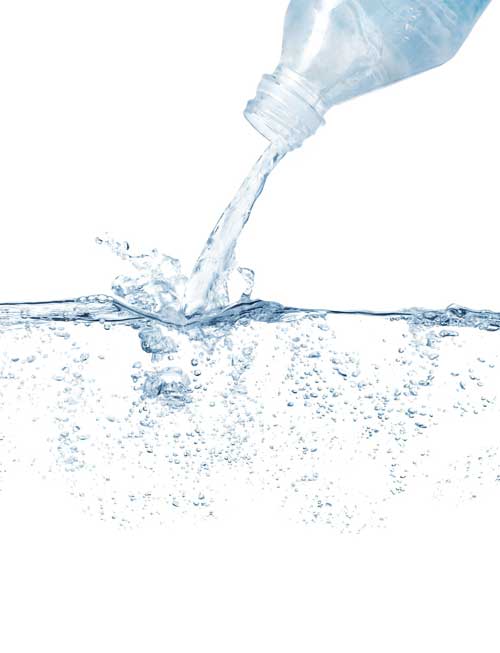
Demineralized Water
To get this water, the dissolved minerals, including salt, are removed completely. This type of water is more economical than distilled water. However, demineralization doesn’t remove viruses and bacteria from your water.
Thanks to the removal of impurities, manufacturers, especially those creating ultrasonic humidifiers, recommend distilled or demineralized water for their devices. This is because ultrasonic humidifiers don’t heat the water, meaning they can’t kill the present impurities. Also, the minerals in the water eventually create scale in the tank, disc, and filter, rendering them ineffective untimely.
Note: Regardless of the type of water you use in your humidifier, you may experience mold growth if you don’t perform proper cleanup on your unit.
Prevent Mold and Bacteria Growth
Mold and bacteria are primary concerns when using humidifiers with large-capacity tanks. These microbes only require stagnant water to thrive. To prevent the infestation of these health hazards, you may utilize the following methods:
- Add White Vinegar
White vinegar is a great enemy to mold and bacteria. As such, after filling your humidifier with water, add a spoonful or cup of white vinegar into the liquid. The ideal quantity of vinegar depends on the amount of water your humidifier’s reservoir can hold.
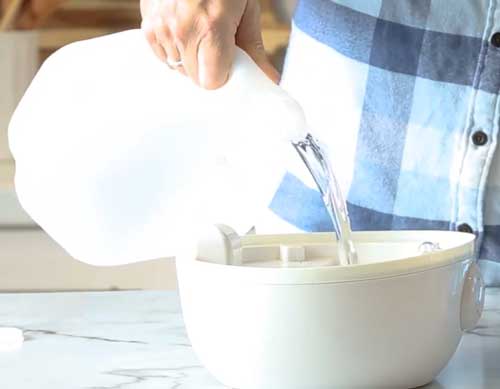
- Utilize Humidifier Tablets
Humidifier tablets are designed to prevent mold growth and slime buildup in your humidifier’s reservoir. You only need to drop one tablet into the tank when refilling it. These tablets dissolve in less than ten minutes, but their effects can last up to a week.
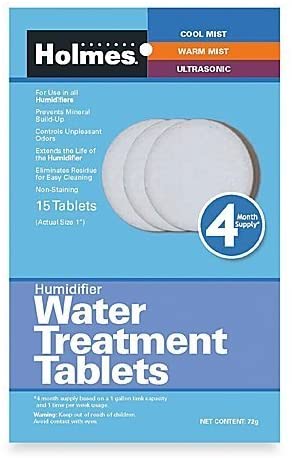
- Use Tea Tree Oil
This organic extract is derived from the Melaleuca plant and features natural antifungal, antiviral, and antibacterial properties. These properties go a long way in preventing mold growth and deterring bacteria and fungi from developing in your humidifier. The extract also functions as a breathing aid for people with respiratory complications like asthma.
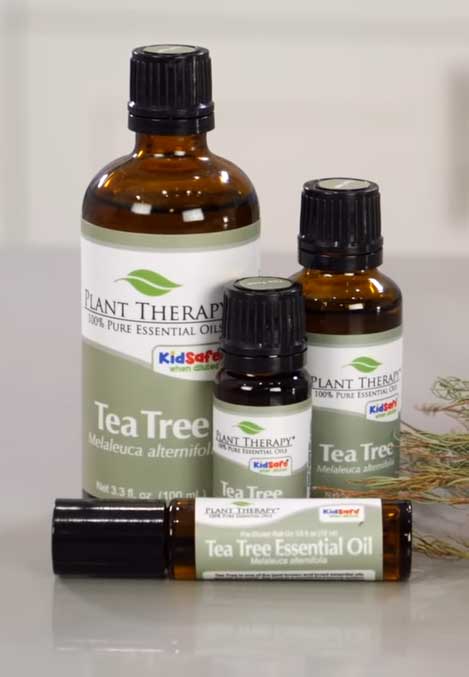
- Hydrogen Peroxide
You may add a few drops of hydrogen peroxide to your humidifier’s reservoir to kill bacteria and mold and it will get the job done.
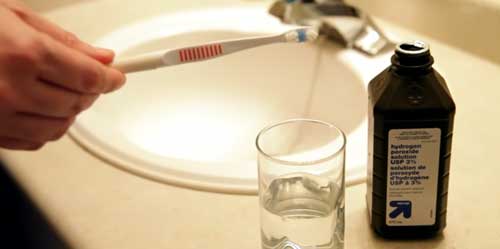
- WARNING: Be very cautious when using this method as it can be dangerous.
Place your Humidifier Properly
While you can place your humidifier just about anywhere, remember to ensure that your chosen space allows optimal air circulation while facilitating full coverage of your room.
- Choose a Nice Spot
Ideally, a large humidifier should stay near a corner and out of your way. However, avoid placing it too close to the walls lest you cause water damage and compromise airflow in and out of the unit, making it inefficient.
We Recommend: If you intend to use your humidifier to improve sleep, our recommendation is to place it close to your bed, especially if it produces a cool mist. On the other hand, a warm mist humidifier should be placed a little farther from the bed where you can’t knock it over.
- Observe Safety
After finding an ideal spot for your device, you need to safeguard it from harm while also protecting your home’s occupants and possessions. This includes positioning the unit at least two feet of the ground and placing a towel, mat, or sheet under the device.
Why is this important?
- Protects the Device from Getting Knocked Over
Placing your device at least two feet off the ground prevents you from knocking it over accidentally. While some humidifiers will automatically switch off when the tank gets tipped, knocking your unit over could damage it and cause water spillage. Warm mists units could also cause burns, especially if the water pours on your feet among other parts of your body.
- Protects your Furniture from Damage
Placing a mat, towel or sheet under your humidifier protects your furniture from water damage, especially if your unit doesn’t have a high plume. The mat also comes in handy in protecting your furniture from water spillage when refilling your reservoir.
Tip: Remember not to place your humidifier too high, especially if it has a long plume, to prevent water damage to your ceiling.
Recommended Humidity Levels to Maintain
A humidifier does a great job of relieving health and comfort issues associated with dry air. However, these units can cause water damage when overused, especially in porous materials like drywall and upholstery. In addition, humidifiers could easily create a perfect breeding ground for bacteria, mold, and dust mites, leading to allergic and respiratory issues like asthma.
Important Note: you need to limit the moisture output from your unit and ensure that humidity levels in your room don’t exceed 50%.
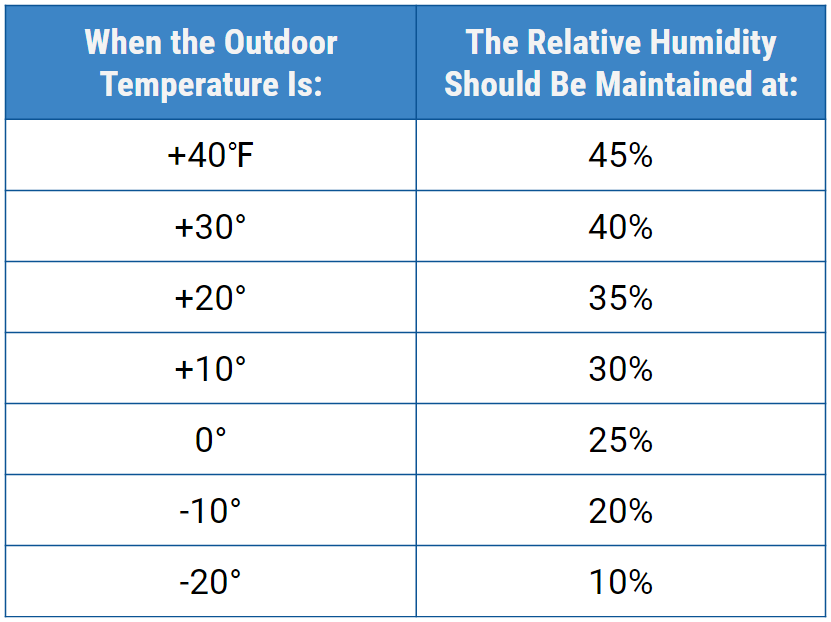
- Some humidifiers come with in-built humidistats that control moisture output automatically by allowing you to pre-select your preferred levels. If your unit doesn’t have a humidistat, you may use a hygrometer with an alarm and set it to notify you when the relative humidity approaches 50% so that you can shut your unit off promptly.
- Also, if your room gets oversaturated after humidification, open the windows and doors until the moisture subsides.
Consider Children’s Safety
Having a humidifier in your kid’s bedroom is a great idea, especially during winter and when your little ones are sick. However, when looking to place the unit in their bedroom, you have to consider their safety and comfort.
As such, keep these tips in mind:
- In kids and baby rooms, silence is paramount; you need to use a super-quiet humidifier. Look for a unit whose noise output doesn’t exceed 40Db.
- If the room requires continuous humidification, it’s advisable to select a humidifier with a humidistat. This feature will control humidification to maintain your pre-selected moisture levels. You may also leave the door slightly open to let out excess moisture. It’s also imperative to get a unit whose tank can hold at least eight hours of moisture.
- It would help if you also contemplated between using a cold-mist or warm-mist humidifier. A cold mist unit is generally safer for your kids and helps with relieving croup, cold, and flu. However, when necessary, you can use a warm-mist device, especially when looking to relieve nasal congestion. However, ensure to find a safe spot for the unit out of your kids’ reach.
Tip: It wouldn’t hurt to use a humidifier with a nightlight, especially if your kids prefer light when sleeping.

Regular Cleaning and Maintenance Tips
Even while using distilled or dematerialized water, you still need to clean your humidifier regularly. This maintenance task eliminates mineral and bacteria traces from the reservoir, ensuring that your next session doesn’t produce contaminated water.
Note: Before you embark on the cleanup chore, ensure to check your user manual for cleaning guidelines. Although all humidifiers have a similar cleaning process, some parts may differ depending on the type and brand.
Here is a quick step-by-step cleanup guide that will help keep your humidifier in optimal condition and improve your indoor air quality:
- With your unit unplugged from the wall, disassemble it completely while adhering to the manufacturer’s instructions. Again, be cautious not to break anything.
- Use white vinegar to clean all the areas that come into contact with water. These parts include the ultrasonic disk, filter, tank cap, and nozzle. You may soak these items in vinegar for about 15 minutes.
- While waiting for these components to soak, fill your reservoir halfway with diluted vinegar or a mild detergent. Close the cap tightly and swish the tank vigorously. If the reservoir has a large opening, you may use a sponge or soft cloth to scrub it by hand. Also, consider soaking it for 15 minutes.
- Rinse all the parts with flowing water and check to ensure that no smell is left lingering on the components. Such odors include the smell of vinegar, detergent, or slime.
- Allow every component to air dry completely before reassembling the unit
Important Note: Pay attention to the manufacturer’s guidelines throughout the cleaning process to ensure that nothing goes wrong. We also recommend deep-cleaning your humidifier at least once a week and before storing your device.
Maintenance Tips
Proper maintenance will ensure that your humidifier runs smoothly for a prolonged period. You can follow these tips:
- Always empty the reservoir and wipe it dry with a cloth when the humidifier is not in use. This will help to prevent mold growth, even when storing the unit for a day
- Turn your wick filter over when refilling the tank to help it age evenly. When the need arises, replace the wick as recommended by your product’s manufacturer.
- Clean or replace the filter after 30 or 60 days of use or as indicated in your user manual
The Bottom Line
Humidifiers have proven time and again to be extremely effective in increasing the moisture levels in your indoor space and easing the health effects of dry air exposure. While these gadgets are relatively easy to use, you will want to follow the above tips to enjoy their full benefits. More importantly, follow the instructions on your user manual when operating and cleaning your humidifier to prevent mishaps.
Placement plays a vital role in protecting you, the humidifier, and your property from harm. Proper cleaning and maintenance also come in handy in keeping your unit effective for a prolonged period.
